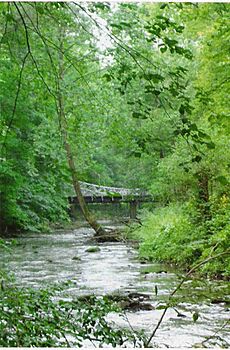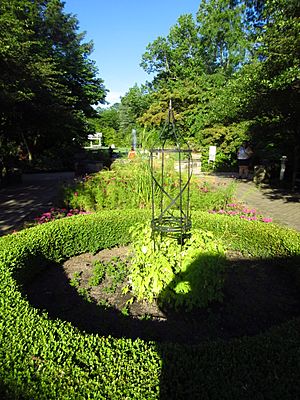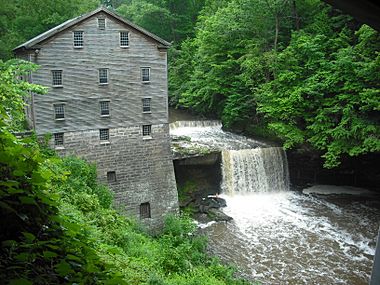Mill Creek Park facts for kids
Mill Creek Park, also known as Mill Creek MetroParks, is a huge park in Youngstown, Ohio. It's so big that one part of it is ranked among the largest parks inside a U.S. city!
This amazing park stretches from one side of Youngstown all the way to its southern edge, reaching into Boardman township. Mill Creek MetroParks covers about 4,400 acres. That's like 6,000 football fields! It has 20 miles of roads and 15 miles of walking trails. You'll also find many bridges, ponds, streams, beautiful gardens, and even waterfalls here. Because of its total size, Mill Creek is one of the biggest city-owned parks in the United States.
Contents
Park History
Mill Creek Park was started in 1891 thanks to the hard work of a Youngstown lawyer named Volney Rogers. He worked tirelessly to buy much of the land for the park. It was a big job because he had to talk to over 90 different landowners!
Once he had the land, Rogers created a special law called the "Township Park Improvement Law." After this law passed, he gave all the land he had bought to be used for the park. The state government officially made the area a park, and it opened in 1893.
Volney Rogers got help from his brother, Bruce, who studied landscape architecture. Bruce became the park's first superintendent, helping to design its look. Later, in 1899, a famous landscape architect named Charles Eliot also helped with the park's design. The well-known Olmsted Brothers firm continued to design parts of the park from 1923 to 1962.
The same year the park opened, local officials issued bonds to pay for the land. Rogers himself bought $25,000 worth of these bonds, agreeing to be paid back last. It's interesting that a big money problem in 1893, called the financial panic of 1893, actually helped the park grow. Many people lost their jobs, but they found work at the park. More bonds were issued to pay their wages. These workers built trails, created roads, fixed up old buildings, and even built a dam for Lake Cohasset.
Fellows Riverside Gardens
Fellows Riverside Gardens is a beautiful public garden located at the northern end of Mill Creek MetroParks. It's free to visit! These twelve acres are filled with many different kinds of plants and colorful displays. You can see all sorts of roses, seasonal flowers, perennials, and flowering bulbs. The gardens also offer amazing views.
The D. D. and Velma Davis Education & Visitor Center makes the gardens a great place to visit all year round. Fellows Riverside Gardens attracts more than 400,000 visitors every year.
Mill Creek Golf Course
The Mill Creek Golf Course has two 18-hole championship courses. They were designed by the famous golfer Donald Ross and opened in 1928. Both courses are "par 70," meaning a good golfer should finish them in 70 strokes. They have different tee locations, making them fun for players of all skill levels.
The South Course is mostly flat with trees lining the fairways. Natural areas and streams are part of the challenge on five of its holes. Golfweek magazine even named the South Course one of America’s 30 Best Municipal Courses. The North Course winds through tall trees and has many natural challenges.
Lanterman's Mill
Lanterman's Mill was built in 1845–46 by German Lanterman and Samuel Kimberly. This historic mill was fixed up between 1982 and 1985 with help from the Ward and Florence Beecher Foundations. It's a special part of the community that shows how early industries worked along Mill Creek. Today, it still grinds corn, wheat, and buckwheat, just like it did in the 1800s!
Close by, the East Gorge Walk and West Gorge Trail let you see the area's cool geologic history. The award-winning Gorge Trail is a two-mile loop along Mill Creek. It has a boardwalk with the stream on one side and a huge sandstone wall on the other.
Ford Nature Center
The Ford Nature Education Center opened in 1972. It's the main place for the park's nature education programs in the northern part of Mill Creek Park. The education center is inside a stone mansion. This mansion was given to the park in 1968 by the children of the late Judge John W. Ford.
Experts called naturalists at the Ford Nature Center offer many programs all year. These include hikes, school programs, workshops, and special events. Inside, you can see displays of plants and animals from four local habitats. There's also a fun, interactive discovery room for kids. Another room has live turtles, snakes, and other animals that live in northeast Ohio. The center also has a library, a bird watching area, and a gift shop. Outside, you can explore wildlife gardens and walking trails.
Lakes, Ponds, and Wetlands
Mill Creek Park has three lakes that were made by people, plus a pond and a wetland area.
Lake Glacier
Lake Glacier was created in 1906. This happened when a dam was built on Mill Creek where it narrowed before reaching the Mahoning River. This 44-acre lake has been a place for fun activities for many years. You can go boating and fishing here during the right season. Kayaks and pedalos are available to rent at the Glacier Boathouse. There's also a boat for rides and group trips. A special fishing dock is available for everyone along West Glacier Drive. Hikers can use the Old Tree Trail and East Glacier Trail.
Lake Newport and Wetlands
In 1924, Alice Baldwin Lewis gave 70 acres of land to the park. She said that part of the land should be used to create a lake. Mill Creek flowed through this shallow valley, making it a good spot for a man-made lake. In 1928, a dam was built, creating what is now called Lake Newport. Lake Newport is the biggest of Mill Creek Park's three lakes. It has 60 acres of open water and 40 acres of wetlands. Boating and fishing are allowed during the season. There's a boat launch on East Newport Drive. Kayaks and pedalos can be rented at the Boathouse on West Newport Drive.
The Newport Wetlands, at the southern end of the lake, are home to many different plants and animals. Visitors can explore this amazing natural area by walking the Albert E. Davies Wetland Trail. This trail is a boardwalk through the wetlands with signs that explain what you're seeing.
Lake Cohasset
Lake Cohasset is the oldest of Mill Creek Park's lakes, built in 1897. It's known for its hemlock trees. The name comes from an Algonquin word, "Conahasset," which means "long rocky place." This 28-acre lake is a quiet spot where visitors can watch wildlife in their natural homes. Boating and fishing are not allowed on Lake Cohasset.
Lily Pond
This four-acre pond has been a popular spot since 1896. Many migrating waterfowl (birds that live near water) and resident goldfish live here. The Lily Pond Circle Trail goes all the way around the pond, giving visitors a nice path for walking and enjoying nature.




